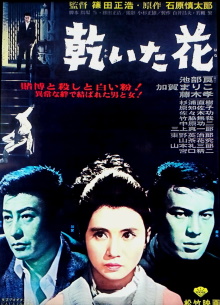This is a yakuza film by a director who is new to us, Masahiro Shinoda though he is known as being as assistant to such famous directors as Yasujirō Ozu. This one is considered a Japanese New Wave film and as such while one can follow the plot readily enough, it’s not so easy to discern what is the point it is driving towards. In the end I think it’s about self-destructive people who to go to extremes in search of a thrill to make themselves feel alive. It’s okay I suppose but not something I am particularly excited about.
Muraki is released from prison following a sentence for murdering another gangster from a rival gang. He returns to his old gang and learns that while he was in prison the boss has decided to ally with the rival gang as a newer, upstart gang has been moving into their turf. Members of the two gangs are told to keep things civil, but a young thug from the other gang tries to kill Muraki anyway but is easily defeated. Muraki feels listless and directionless until he runs into a young woman, Saeko, in a gambling den. She loses large amounts of money but professes to be bored by the small stakes involved. She asks Muraki to introduce her to some higher stakes games and he complies. Her presence at the games seems disruptive at first but she is such a serious gambler that the other gangsters soon welcome her. Muraki at first thinks of her as merely being a gambling addict but soon realizes that she is similar to him and continually seeks out ever greater thrills in order to feel alive.
With gangster films, one is conditioned to expect certain tropes and story beats: a violent turf war perhaps or dramatic betrayals. None of this really happens here as this is a character-driven film, not a plot-driven one, so you’re going to be sorely disappointed if you are expecting a conventional gangster film. Perhaps one of most illuminating scenes is when Muraki and Saeko are returning from a gambling den in her car at 2.30 in the morning and randomly get into an impromptu street race with another car. Despite the ridiculous speeds and obvious danger, both are uproarious and so is the stranger who drives the other car. It’s not even about winning at all, it’s simply the thrill of the experience. This is a film about characters trapped in ennui, who go through the motions of life but can find no purpose in it. I suppose it’s good for the film to have such artistic aspirations but I didn’t find this to be a particularly original treatment of the theme.
The film is pretty unambiguous in that a singular obsession with chasing thrills can only ever end in tragedy. In that sense, this is still a much more conservative take on societal values than its European counterparts which would more readily valorize the individual above society in general. It is a little surprising that someone like Saeko wouldn’t have encountered drugs earlier and Muraki is very vehement about warning her against them. As far as I can tell, the character of Yon, the creepy drug-addicted punk, exists only as a warning of the horror at the end of Saeko’s path while also adding a bit of action to the film.
The film does some interesting things with regards to visuals and sound and it is recognizably New Wave in its focus on characters instead of plots. But it’s still in service of traditional Japanese values and mores so it’s not that groundbreaking and films about thrill-seeking addicts are hardly anything new.
